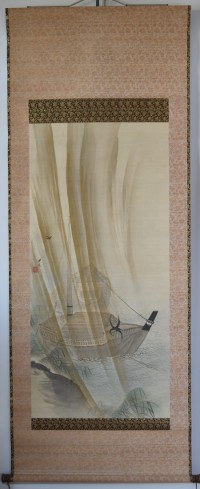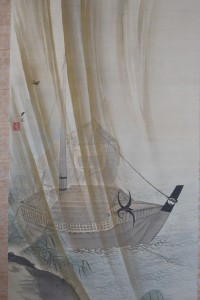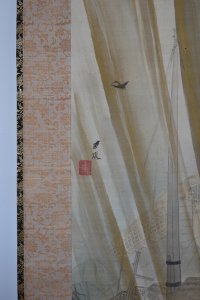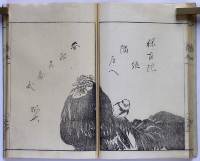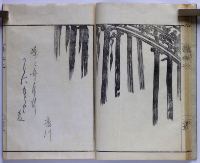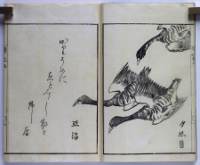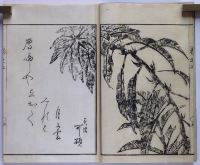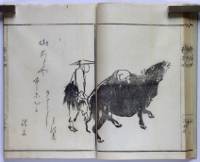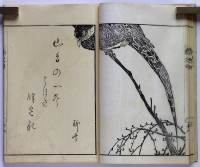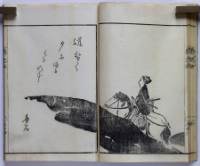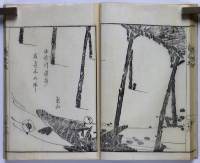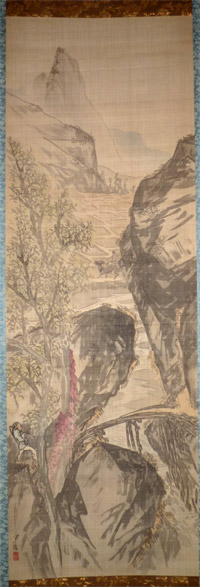Cho GESSHO (1772-1832)
Click here to view image full size.
A large original painting of moored junks caught in a violent squall. A fine painter who studied under Tanke Gessen and Matsumura Goshun in Kyoto before moving to Nagoya in 1798 and becoming Nagasawa Rosetsu’s assistant for a short time. Also illustrated some fine ehon. Sumi and colour on silk with the currents of air painted in gold; 55.25 x 26 in; 140.25 x 66 cms. Painted c. 1810s. Provenance: Two previous owners’ seals on the exterior of mount: The Honda family library and the Ueno family. Old box with inscription which states that Gessho wanted to acquire a painting from the Owari district. Although not intrinsically valuable it was esteemed by the local people. He offered to exchange the painting offered here for their painting. There is a dig here in that the inhabitants of Owari were known to be avaricious. Written by Mizutani Okurei (1848-1926). Presumably based on the accounts of the two previous family owners.
Signed Gessho with seal: Yukisada, Genkei, Gessho. Obviously an important painting by Gessho and in very good condition.
Status: Available
Cho GESSHO (1772-1832) and Kazaore YUJO (fl. c. 1790-1800)
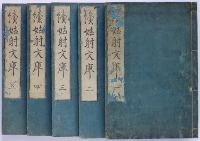
Click here to view image full size.
5 vols. complete: Zoku Koya Bunko, “The Sequel to Koya Library.” Vol. 1: 52 sheets; 48 illus. Vol. 2: 49 sheets; 48 illus. Vol. 3: 53 sheets; 51 illus. Vol. 4: 53 sheets; 52 illus. Vol. 5: 56 sheets; 54 illus. Preface, 5 pp. by Kogetsutei, dated Kansai 9 (1797). Artists: Kazaore Yujo and Cho Gessho. Published by Fugetsu Magosuke, Nagoya, Kansai 10 (1798), together with other publishers in Edo, Osaka and Kyoto. The greatest anthology of printed haiga (haiku poems accompanied by illustrations based on simple, yet often profound, observations of everyday life). The anthology was started by Yujo but taken over by Gessho on his death. Most of the work is Gessho’s. This is one of the few books where the block-cutter and printer must take pride of place beside the artist. The most striking effects were achieved by these artisans by imaginative working of the block surface and wiping of the blocks to produce distinctive variations in texture and formless adumbrations of trees, plants and landscapes, all in sumi. Other examples: Duret 464 (5 vols. 1799); Gonse (III), 438 (4 vols., 1798); Holloway 18; Ryerson, pl. XI. Original covers and title slips. Some slight damage to covers and slight restored wormage at bottom of first sheets of vol. 1. But otherwise an exceptionally fine and clean copy with hardly any thumbing on corners. A lovely and rare set.
Status: Sold
Cho GESSHO (1772-1832)
Click here to view image full size.
An original painting showing an autumnal scene with a woodcutter carrying an axe and about to cross a bridge over a river that flows down from paddy fields with steep cliffs above. In the mid-distance a man on a bullock. Gessho was the son of a kakemono-mounter and, after studying with Goshun and Gessen in Kyoto, moved to Nagoya, where he stayed to become the leading artist with Baiitsu and Kinkoku. Well known for haiga and kyoka anthologies such as Fukei gaso and Zoku koya bunko. Sumi and colour on silk. Image size 38.25 x 13 in; 97 x 33 cms. Very good condition. Old mount and box with inscription Shusansui Gessho ga ifuku ( “one scroll” ). Signed Gessho with seals Yukisada ( Gyotei ).
Status: Sold
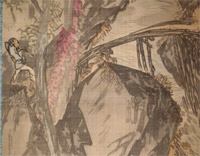
Click here to view image full size.
